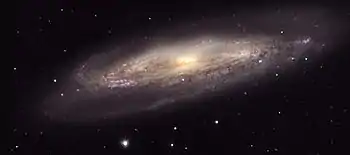Messier 98
Messier 98, M98 or NGC 4192, is an intermediate spiral galaxy about 44.4[3] million light-years away in slightly northerly Coma Berenices, about 6° to the east of the bright star Denebola (Beta Leonis). It was discovered by French astronomer Pierre Méchain on 1781,[lower-alpha 1] along with nearby M99 and M100, and was catalogued by compatriot Charles Messier 29 days later in his Catalogue des Nébuleuses & des amas d'Étoiles.[4] It has a blueshift, denoting ignoring of its fast other movement (vectors of proper motion), it is approaching at about 140 km/s.[2]
| Messier 98 | |
|---|---|
 Messier 98 | |
| Observation data (J2000 epoch) | |
| Constellation | Coma Berenices |
| Right ascension | 12h 13m 48.292s[1] |
| Declination | +14° 54′ 01.69″[1] |
| Redshift | −0.000474[2] |
| Helio radial velocity | −142 ± 4 km/s[2] |
| Distance | 44.4 million light years (13.6 Mpc)[3] |
| Apparent magnitude (V) | 11.0[4] |
| Characteristics | |
| Type | SAB(s)ab[3] |
| Apparent size (V) | 9′.8 × 2′.8[4] |
| Other designations | |
| NGC 4192, UGC 7231, PGC 39028[2] | |
The morphological classification of this galaxy is SAB(s)ab,[3] which indicates it is a spiral galaxy that displays mixed barred and non-barred features with intermediate to tightly wound arms and no ring.[5] It is highly inclined to the line of sight at an angle of 74°[6] and has a maximum rotation velocity of 236 km/s.[7] The combined mass of the stars in this galaxy is an estimated 76 billion (7.6 × 1010) times the mass of the Sun. It contains about 4.3 billion solar masses of neutral hydrogen and 85 million solar masses in dust.[8] The nucleus is active, displaying characteristics of a "transition" type object. That is, it shows properties of a LINER-type galaxy intermixed with an H II region around the nucleus.[9]
Messier 98 is a member of the Virgo Cluster, which is a large cluster of galaxies, part of the local supercluster.[10]
About 750 million years ago, it may have interacted with the large spiral galaxy Messier 99. These are now separated by 1,300,000 ly (400,000 pc).[7]
Gallery
 Messier 98 taken by Hubble Space Telescope.[11]
Messier 98 taken by Hubble Space Telescope.[11]
 M98, as seen by the Hubble Space Telescope
M98, as seen by the Hubble Space Telescope Spiral galaxy M98, by HST (WFPC2).
Spiral galaxy M98, by HST (WFPC2).
See also
- Messier 86, another blueshifted galaxy
References
- Skrutskie, M. F.; et al. (February 2006), "The Two Micron All Sky Survey (2MASS)", Astronomical Journal, 131 (2): 1163–1183, Bibcode:2006AJ....131.1163S, doi:10.1086/498708.
- "NASA/IPAC Extragalactic Database". Results for Messier 98. Retrieved 18 November 2006.
- Erwin, Peter; Debattista, Victor P. (May 2013), "Peanuts at an angle: detecting and measuring the three-dimensional structure of bars in moderately inclined galaxies", Monthly Notices of the Royal Astronomical Society, 431 (4): 3060–3086, arXiv:1301.0638, Bibcode:2013MNRAS.431.3060E, doi:10.1093/mnras/stt385, S2CID 54653263.
- Thompson, Robert; Thompson, Barbara (2007), Illustrated Guide to Astronomical Wonders: From Novice to Master Observer, Diy Science, O'Reilly Media, Inc., p. 196, ISBN 978-0596526856.
- Buta, Ronald J.; et al. (2007), Atlas of Galaxies, Cambridge University Press, pp. 13–17, ISBN 978-0521820486.
- Schoeniger, F.; Sofue, Y. (July 1997), "The CO Tully-Fisher relation for the Virgo cluster", Astronomy and Astrophysics, 90: 1681–1759, Bibcode:1997A&A...323...14S.
- Duc, Pierre-Alain; Bournaud, Frederic (February 2008), "Tidal Debris from High-Velocity Collisions as Fake Dark Galaxies: A Numerical Model of VIRGOHI 21", The Astrophysical Journal, 673 (2): 787–797, arXiv:0710.3867, Bibcode:2008ApJ...673..787D, doi:10.1086/524868, S2CID 15348867.
- Davies, J. I.; et al. (February 2012), "Studies of the Virgo Cluster. II – A catalog of 2096 galaxies in the Virgo Cluster area", Monthly Notices of the Royal Astronomical Society, 419 (4): 3505–3520, arXiv:1110.2869, Bibcode:2012MNRAS.419.3505D, doi:10.1111/j.1365-2966.2011.19993.x, S2CID 56474905.
- Terashima, Yuichi; et al. (1985), "ASCA Observations of "Type 2" LINERs: Evidence for a Stellar Source of Ionization", The Astrophysical Journal, 533 (2): 729–743, arXiv:astro-ph/9911340, Bibcode:2000ApJ...533..729T, doi:10.1086/308690, S2CID 14130773.
- Binggeli, B.; Sandage, A.; Tammann, G. A. (1985), "Studies of the Virgo Cluster. II – A catalog of 2096 galaxies in the Virgo Cluster area", Astronomical Journal, 90: 1681–1759, Bibcode:1985AJ.....90.1681B, doi:10.1086/113874.
- "Trillions of stars". www.spacetelescope.org. Retrieved 24 June 2019.
- "Why So Blue?". www.eso.org. Retrieved 5 September 2016.
- 15 March
External links
| Wikimedia Commons has media related to Messier 98. |
- Spiral Galaxy M98 @ SEDS Messier pages
- Messier 98 on WikiSky: DSS2, SDSS, GALEX, IRAS, Hydrogen α, X-Ray, Astrophoto, Sky Map, Articles and images
- Messier Object 98
